Traxxas LP TRX1018 Traxxas Link wireless module User Manual 1
Traxxas LP Traxxas Link wireless module Users Manual 1
Contents
Users Manual-1
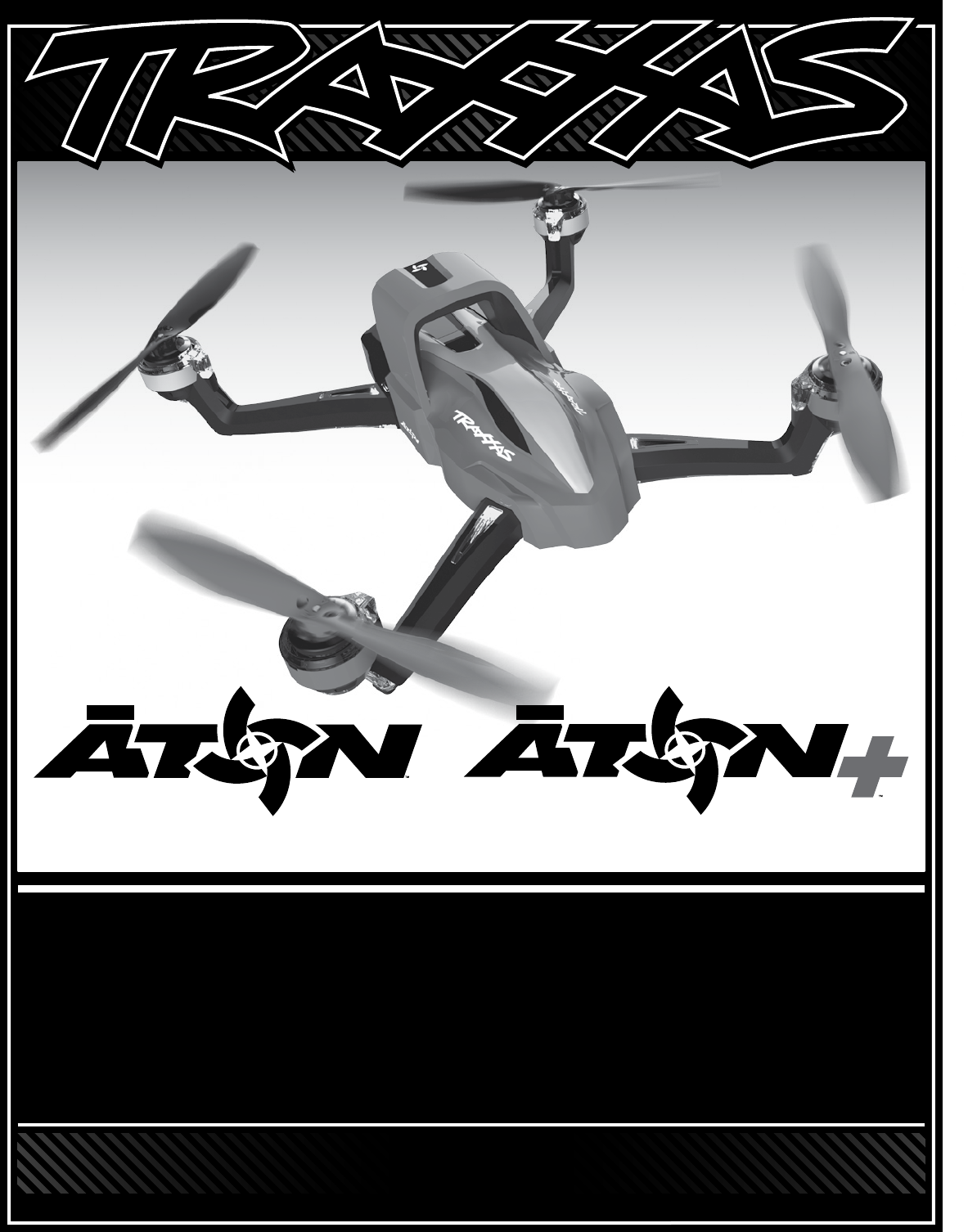
KC2363-R05 160324
OWNER’S MANUAL
MANUEL DU PROPRIÉTAIRE
MANUAL DEL USUARIO
BEDIENUNGSANLEITUNG
MODEL 7908 MODEL 7909
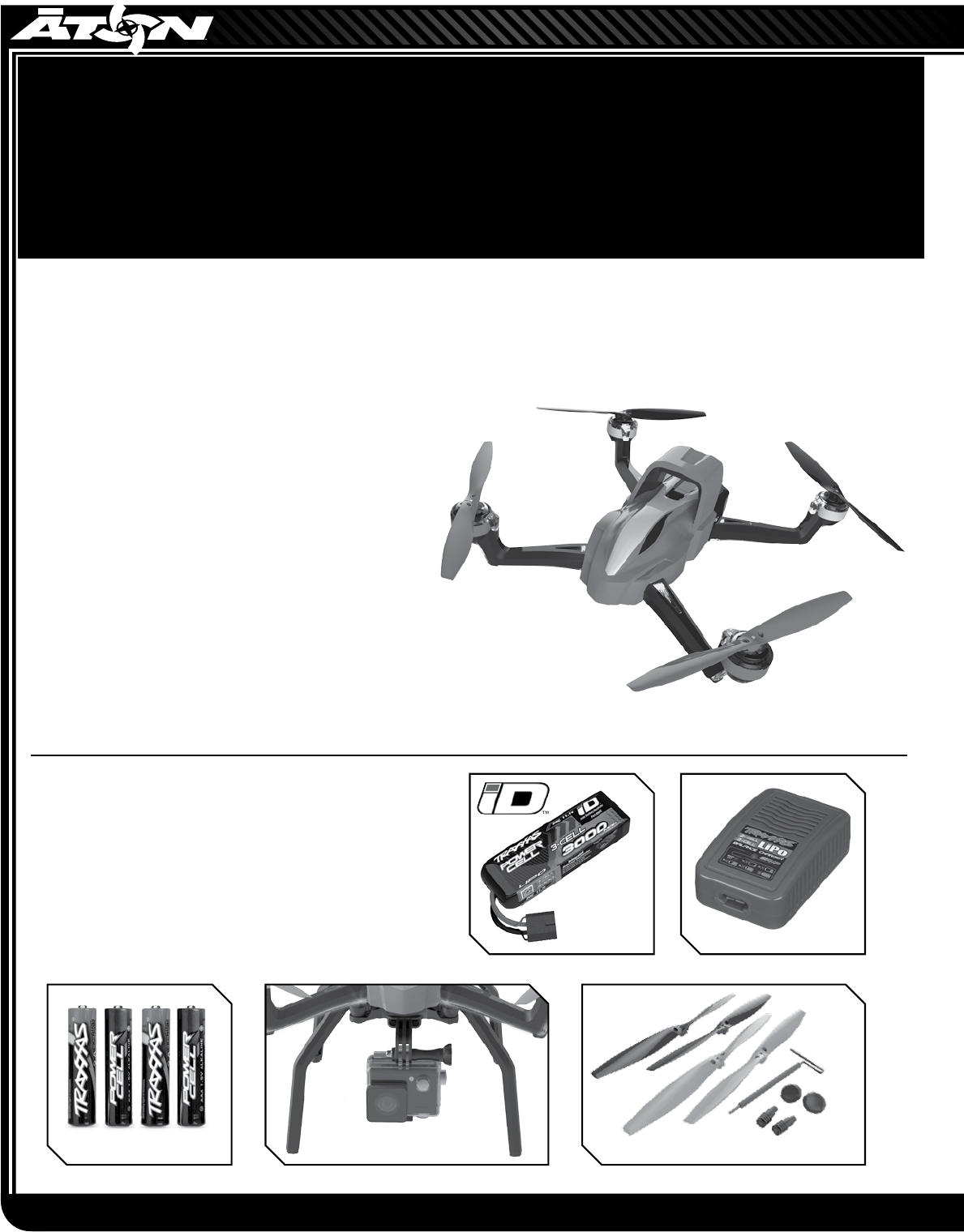
2 • TRAXXAS
GoPro is a registered trademark of GoPro, Inc.
*Compatible with GoPro® Hero3, Hero3+, or Hero4
INTRODUCTION
Thank you for purchasing the Traxxas Āton quad rotor high
performance helicopter. This manual contains the instructions you
will need to operate and maintain your model. Even if you are an
experienced R/C enthusiast, it’s important to read and follow the
procedures in this manual so that you are fully knowledgeable on
the operation and care of your Āton. We want you to feel confident
that you own one of the best-performing models in the market
and that it is backed by a team of professionals who aim to provide
the highest level of factory support possible. Our Customer
Support team is with you every step of the way. If you have any
questions about your model or its operation, call the Traxxas
Technical Support Line toll-free at: 1-888-TRAXXAS (1-888-872-
9927) (Toll-free support is available to U.S. residents only).
QUICK START GUIDE
See the included Quick Start Guide for initial setup of your
helicopter. The Quick Start Guide is not intended to replace the
full operating instructions available in this manual. Please read
this entire manual to become familiar with the controls and
operations of the model before attempting to fly it the first time.
CONTENTS
INTRODUCTION......................................................................................................... 2
INCLUDED SUPPORT EQUIPMENT ........................................................................... 2
MODEL ORIENTATION ............................................................................................... 2
KNOW BEFORE YOU FLY ........................................................................................... 3
FLIGHT CONTROLS ................................................................................................... 4
SAFETY PRECAUTIONS ............................................................................................. 5
PREPARING FOR FLIGHT..........................................................................................6
FLYING YOUR MODEL ............................................................................................... 7
AUTO TAKE-OFF ........................................................................................................ 7
RETURN TO HOME .................................................................................................... 7
FLIGHT MODES .......................................................................................................10
FILM MODE ......................................................................................................10
SPORT MODE ..................................................................................................11
EXPERT MODE ................................................................................................. 12
CARING FOR YOUR HELICOPTER .......................................................................... 12
ROTOR BLADE INSTALLATION ...............................................................................12
TROUBLESHOOTING GUIDE ...................................................................................13
MODEL ORIENTATION
REAR
Black Rotor Blades
White Lights
FRONT
Color Rotor Blades
Red Lights
• High capacity LiPo iD battery
• LiPo battery charger with AC power cord
• 4 Traxxas AAA alkaline batteries
• Landing gear with hardware
• Camera mounting bracket with hardware
(designed for use with GoPro® action cameras*)
• 2mm hex wrench (to assist with repairs)
• Spare rotor blade set
• Spare hardware
• Transmitter sticks (interchangeable with the thumb pads)
*Camera not included
All instructions and precautions outlined in this manual should be strictly followed to ensure safe operation of your model.
Failure to comply with the warnings, instructions, and precautions in this manual could lead to product damage and personal injury.
INCLUDED SUPPORT EQUIPMENT
LiPo Battery
AAA Batteries Hex Wrench, Spare Parts, and Accessories
Landing Gear and Camera Mount
LiPo Charger
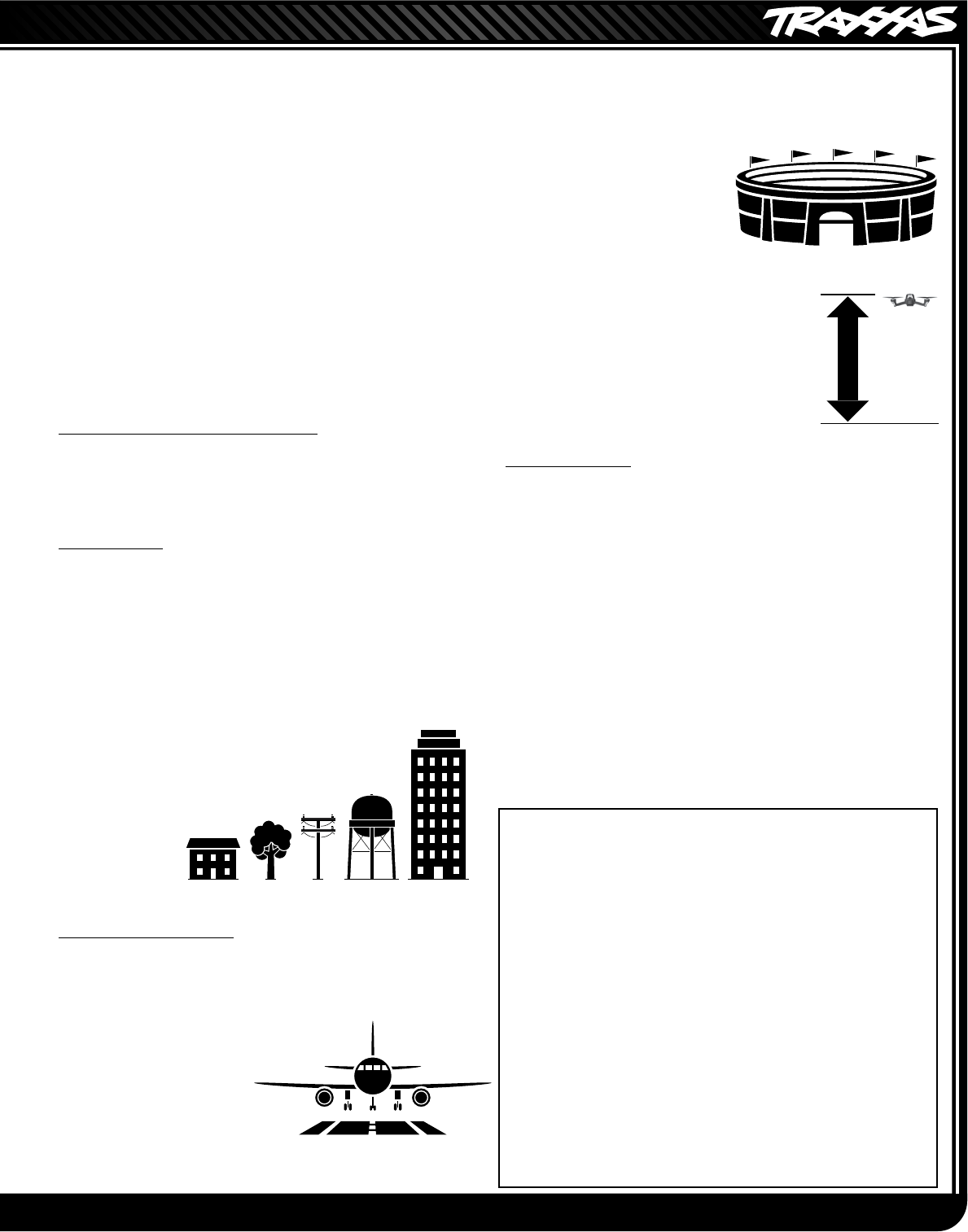
TRAXXAS • 3
KNOW BEFORE YOU FLY
Welcome to the world of fun and excitement with model aviation.
The Āton is designed for the purpose of easily capturing beautiful
and exciting imagery or to explore the freedom of flight just for the
fun of it. The included Quick Start Guide contains an overview of the
operation of the Āton and the steps you need to take to get flying
quickly. We recommend that you review both the Quick Start Guide
and this full Owner’s Manual so that you are fully knowledgeable on
the operation and care of your Āton. This will help you maintain and
enjoy the model for years to come. Traxxas support is always available
to answer your questions and help you with any issues you may
encounter. Our contact information is on the previous page.
The Āton is a high performance model that has tremendous power
and capability. With that comes the responsibility to read, understand,
and follow all warnings, precautions, and instructions to ensure the
safe operation of the model. Failure to operate the model in a safe and
responsible manner may result in property damage and serious injury
to yourself and others. As the pilot, you alone are responsible for
ensuring that all instructions and precautions are adhered to.
Your Important Responsibility as a Pilot
The Āton must operate in shared air space with other model aircraft and
more importantly, full-sized aircraft. It is critically important to choose
a flying/filming location that meets the rules and regulations that have
been established by local and national regulating bodies so that you will
not create a hazard for any other aircraft in flight or person on the ground.
Where Can I Fly:
Choose a location that offers plenty of open space, away from people.
Your Āton is controlled by radio which is subject to interference from
sources beyond your control. Fly in locations that minimize any possible
risk to people or property if you somehow lose control of your model.
1. Some areas such as parks or schools may be restricted for operation
of radio control models. Look for posted signs or check with local
authorities.
2. Look for natural or man-made obstacles that can interfere with your
flight or block your line of site to the model. Examples include:
• Tree lines
• Power lines
• Buildings
• Light poles
• Water towers
3. You must be able
to maintain line
of sight to your
model at all times
during flight.
Places You Should Not Fly:
The Federal Aviation Administration (FAA) governs the use of
US airspace. The FAA classifies the Āton as an unmanned aircraft
system (UAS) and RC model pilots are expected to comply with FAA
regulations and restrictions for UASs.
• Do Not Fly over roads or highways
where your model could disrupt
or distract passing traffic.
• Do Not Fly within a 5-mile
radius of an airport without
first contacting the tower or
airport authorities.
• Do Not Interfere with manned aircraft operations, and you must see
and avoid other aircraft and obstacles at all times. If you are able to
fly near manned aircraft then it is likely you are flying in a restricted
area. Land immediately and find another location.
• Do Not Fly in areas with temporary flight restrictions. Examples of
temporary flight restrictions include but are not limited to:
• Sports stadiums and other
similar venues
• Racetracks
• Disaster and hazard areas
(such as fires or traffic accidents)
• Large public gatherings
• Consult with local airport officials to determine if there are flight
restrictions where you intend to fly.
• Do Not Fly near or over sensitive infrastructure
or property such as power stations, water
treatment facilities, correctional facilities, heavily
traveled roadways, government facilities, etc.
• Limit your altitude to 400 feet (122 meters)
maximum.
• Check and Follow all local laws and ordinances
before flying or filming over private property.
Safety for Everyone
• Do Not Fly while impaired by any substance or physical ailment.
• Do Not intentionally fly over unprotected persons or moving
vehicles, and remain at least 25 feet (7.5 meters) away from
individuals and vulnerable property.
• Do Not Fly in adverse weather conditions such as in high winds or
reduced visibility.
• Keep your model in sight at all times.
• Do Not conduct surveillance or photograph persons in areas where
there is an expectation of privacy without the individual’s permission.
• Maintain your model to prevent mechanical problems.
• Do Not Attempt to rescue your model in dangerous areas or
conditions. If the model does get tangled in trees, power lines, or
lands on rooftops, in water, and so on, do not risk personal injury or
death to yourself or others attempting to retrieve the model.
• Know How to disarm your model. If a bystander approaches
the model while in operation, land and disarm immediately to
prevent injury. Spinning props are dangerous. Keep spectators and
bystanders well clear of the model while in operation.
Who is Know Before You Fly?
Know Before You Fly is an education campaign founded by the Association
for Unmanned Vehicle Systems International (AUVSI), the Academy of Model
Aeronautics (AMA), and the Small UAV Coalition in partnership with the
Federal Aviation Administration (FAA) to educate prospective users about
the safe and responsible operation of unmanned aircraft systems (UAS). At
the Know Before You Fly website you will find additional information and
useful links to learn even more about safe flying. For more information visit
www.knowbeforeyoufly.org
No Commercial Use
The Āton is intended for personal recreational use. At the time this
publication was created, the FAA requires anyone using an unmanned
aircraft system for non-hobby purposes to acquire authorization from
the FAA. Non-hobby purposes include but are not limited to commercial
activities such as for-hire film and photography services, real estate and
wedding photography, commercial film and television production, and
for-hire inspection and survey services. For more information on what types
of activities constitute non-hobby use and how to obtain authorizations and
exemptions, visit www.faa.gov/uas.
For operation outside of the US, be sure to consult regulations specific to
your country and/or local region..
400 feet
(122
meters)
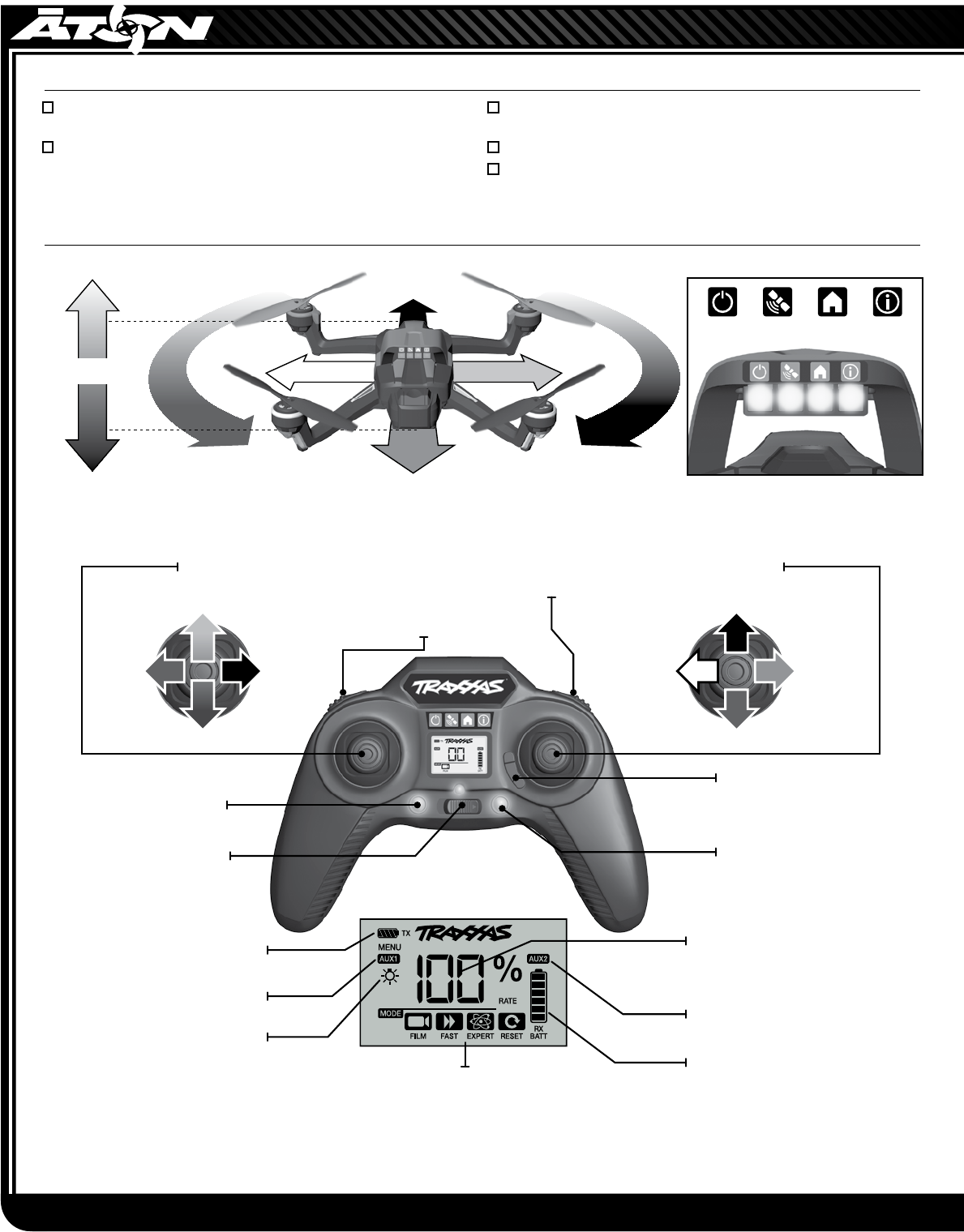
4 • TRAXXAS
Read all manufacturer supplied instructions and precautions
before attempting to operate the model.
Make sure that you as a pilot are competent and proficient in the
operation of your model. It is important to become familiar with
the controls and operations of the model before attempting to
operate it the first time.
Make sure that your batteries are charged and the model is fully
operational. Do not operate a damaged or malfunctioning model.
Make sure you have a GPS satellite signal.
Make sure the operating environment is safe.
• Altitude Up
• Altitude Down
• Altitude Hold
• Sideways
Right
• Forward• Rotate Left • Rotate Right
• Sideways
Left
• Backward
AUX1 Button
Default Setting:
Initiate Trick Sequence
(Sport (Fast) Mode only;
see Owner’s Manual for details)
Return to Home Button
Arm/Disarm Button
Menu Navigation
(Up/Down)
Power Switch
Throttle Stick
Press and release to enter transmitter menu while disarmed
Flight Stick
Press and release to change Flight Mode while disarmed
Air Brake Button
(AUX2)
Transmitter Battery
Charge Level
AUX1 Status Indicator
Helicopter Lights Status
Helicopter Battery
Charge Level
LCD Screen
Rotate
Right Sideways
Right
Rotate
Left Sideways
Left
Down
Hold
Backward
Up Forward
Throttle Rate
HOLD
AUX2 Status Indicator
Controls (Mode 2 Operation)
Pre-Flight Checklist
Status Bar
Power Home InfoGPS
Mode Indicator

TRAXXAS • 5
SAFETY PRECAUTIONS
• Never fly the helicopter with low batteries. Low battery indicators
include:
• The transmitter or the receiver battery level indicator on the
transmitter LCD starts flashing, and the transmitter starts beeping
continuously.
• The rear-facing green Info Status LED on the helicopter is flashing.
• The helicopter loses power and lands itself (low voltage cutoff).
• Alert tones from the transmitter.
• Automatic return to home.
• The helicopter has rotating blades that move at high speed, posing
danger of damage and injury. Pilots are responsible for any actions
that result in damage or injury from the improper operation of the
helicopter. Choose an adequate flying space without obstacles.
Do not operate the helicopter near buildings, crowds of people,
high-voltage power lines, or trees to ensure the safety of yourself,
others, and your model. Wear eye protection when operating your
helicopter and keep your hands, face, hair, loose clothing, and
foreign objects away from the rotating blades.
• This model has small parts that may pose a choking hazard. Keep
all small parts and electrical devices out of the reach of children and
animals.
• Pets can become excited by radio-controlled models. Keep pets away
from your model at all times.
• Your Āton is controlled by radio which is subject to interference
from sources beyond your control. Radio interference can cause
momentary losses of radio control; always allow a safety margin in all
directions around the model to prevent collisions.
• Do not attempt to rescue your model in dangerous areas or
conditions. If the model does get tangled in trees, power lines, or
lands on rooftops, in water, and so on, do not risk personal injury or
death to yourself or others attempting to retrieve the model.
• Do not fly while impaired by any substance or physical ailment.
• Moisture causes damage to electronics. Avoid exposing your model,
transmitter, and battery to water.
• The motor, batteries, and speed control can become hot during use.
Allow parts to cool before handling.
• Do not leave the model unattended while it is turned on.
Immediately turn the model and the transmitter off after you have
safely landed the model.
• Most importantly, use good common sense at all times.
TERMS OF USE - The buyer assumes all risk associated with using this
product. Traxxas, its affiliates, manufacturers, distributors, and retail
partners cannot control the use, application, charging or installation of
this product and shall not be held responsible for any accident, injury to
persons, or damage to property resulting from the use of this product.
After reading all, if you do not agree with these terms and conditions
and are not prepared to accept complete liability for the use of this
product, return this product immediately in new/unused condition to
your place of purchase. Your retailer absolutely cannot accept product
for return or exchange if it has been used in any way.
If you have any questions, call Traxxas Customer Support at
1-888-TRAXXAS (1-888-872-9927). Outside the US, call +1-972-549-
3000 or e-mail support@traxxas.com.
WARNING! CAUTION! DANGER!
FIRE HAZARD! Charging and discharging batteries has the potential for fire, explosion,
serious injury, and property damage if not performed per the instructions. In addition,
Lithium Polymer (LiPo) batteries pose a SEVERE risk of fire if not properly handled per
the instructions and
require special care and handling procedures for long life and
safe operation. WARNING: LiPo batteries are intended only for advanced users that are educated on
the risks associated with LiPo battery use. Traxxas does not recommend that anyone under the age
of 14 use or handle LiPo battery packs without the supervision of a knowledgeable and responsible
adult. Dispose of used batteries according to the instructions.
• Your model requires the use of LiPo batteries. LiPo batteries have a minimum safe discharge
voltage threshold that should not be exceeded. The Traxxas
Ā
ton is equipped with built-in
Low-Voltage Detection that alerts the pilot when LiPo batteries have reached their minimum
voltage (discharge) threshold. It is the pilot’s responsibility to stop immediately to prevent the
battery pack from being discharged below its safe minimum threshold.
• Low-Voltage Detection is just one part of a comprehensive plan for safe LiPo battery use.
It is critical to follow all instructions for safe and proper charging, use, and storage of LiPo
batteries. Make sure you understand how to use your LiPo batteries. If you have questions
about LiPo battery usage, please consult with your local hobby dealer or contact the battery
manufacturer. As a reminder, all batteries should be recycled at the end of their useful life.
• The included LiPo battery pack must be charged ONLY with a Lithium Polymer (LiPo) balance
charger, such as the included LiPo balance charger, the Traxxas EZ-Peak Plus, part #2970, or the
Traxxas EZ-Peak Dual, part #2972. Only use a LiPo charger compatible with Traxxas iD batteries.
If you are using a LiPo balance charger that is not compatible with Traxxas iD batteries, the
Traxxas balance adapter (part #2938) is required.
• DO NOT use a charger designed for NiMH or NiCad batteries. Failure to use the correct charger may
result in battery damage, fire, personal injury, and/or property damage.
• The use of a NiMH or NiCad charger or charge mode will damage the batteries and may cause fire
and personal injury.
• ALWAYS inspect your LiPo batteries carefully before charging. Do not use or charge battery packs that
have been damaged in any way (bent, dented, swollen, torn covering, or otherwise damaged).
• DO NOT remove or change the connector on Traxxas iD batteries. Changing the connector could
remove the ability to balance charge the battery pack.
• BEFORE you charge, ALWAYS confirm that the charger settings exactly match the type (chemistry),
specification, and configuration of the battery to be charged. DO NOT exceed the maximum
manufacturer recommended charge rate. DO NOT attempt to charge non-rechargeable batteries
(explosion hazard), batteries that have an internal charge circuit or a protection circuit, or batteries
that have been altered from original manufacturer configuration.
• While charging or discharging, ALWAYS place the battery (all types of batteries) in a fire
retardant/fire proof container and on a non-flammable surface such as concrete.
• ALWAYS charge batteries in a well-ventilated area.
• Charge the battery in a safe area away from flammable materials. Monitor the charging process
and never leave batteries unattended while charging. Do not allow small children to charge or
handle LiPo batteries.
• DO NOT disassemble, crush, short circuit, or expose the batteries to flame or other source of
ignition.
• DO NOT let any exposed battery contacts or wires touch each other. This will cause the battery to
short circuit and create the risk of fire.
• DO NOT leave the charger and battery unattended while charging, discharging, or anytime the
charger is ON with a battery connected. If there are any signs of a malfunction, unplug the power
source and/or stop the charging process immediately.
• ALWAYS unplug the charger from the wall outlet and disconnect the battery when not in use.
• Never charge LiPo battery packs in series or parallel with this charger. Charging packs in series or
parallel may result in improper charger cell recognition and an improper charging rate that may
lead to overcharging, cell imbalance, cell damage and fire.
• If a battery gets hot to the touch during the charging process (temperature greater than 110°F /
43°C), immediately disconnect the battery from the charger and discontinue charging.
• DO NOT store or charge LiPo batteries with or around other batteries or battery packs of any
type, including other LiPos.
• Store and transport your LiPo batteries in a cool dry place. DO NOT store in direct sunlight. DO
NOT allow the storage temperature to exceed 140°F or 60°C or the cells may be damaged and risk
of fire created. ALWAYS store battery packs safely out of the reach of children and pets.
• Keep a Class D fire extinguisher nearby in case of fire.
• DO NOT disassemble LiPo batteries or cells. DO NOT disassemble the charger.
• DO NOT attempt to build your own LiPo battery pack from loose cells.
• REMOVE the battery from your model or device before charging.
• DO NOT expose the charger to water or moisture.
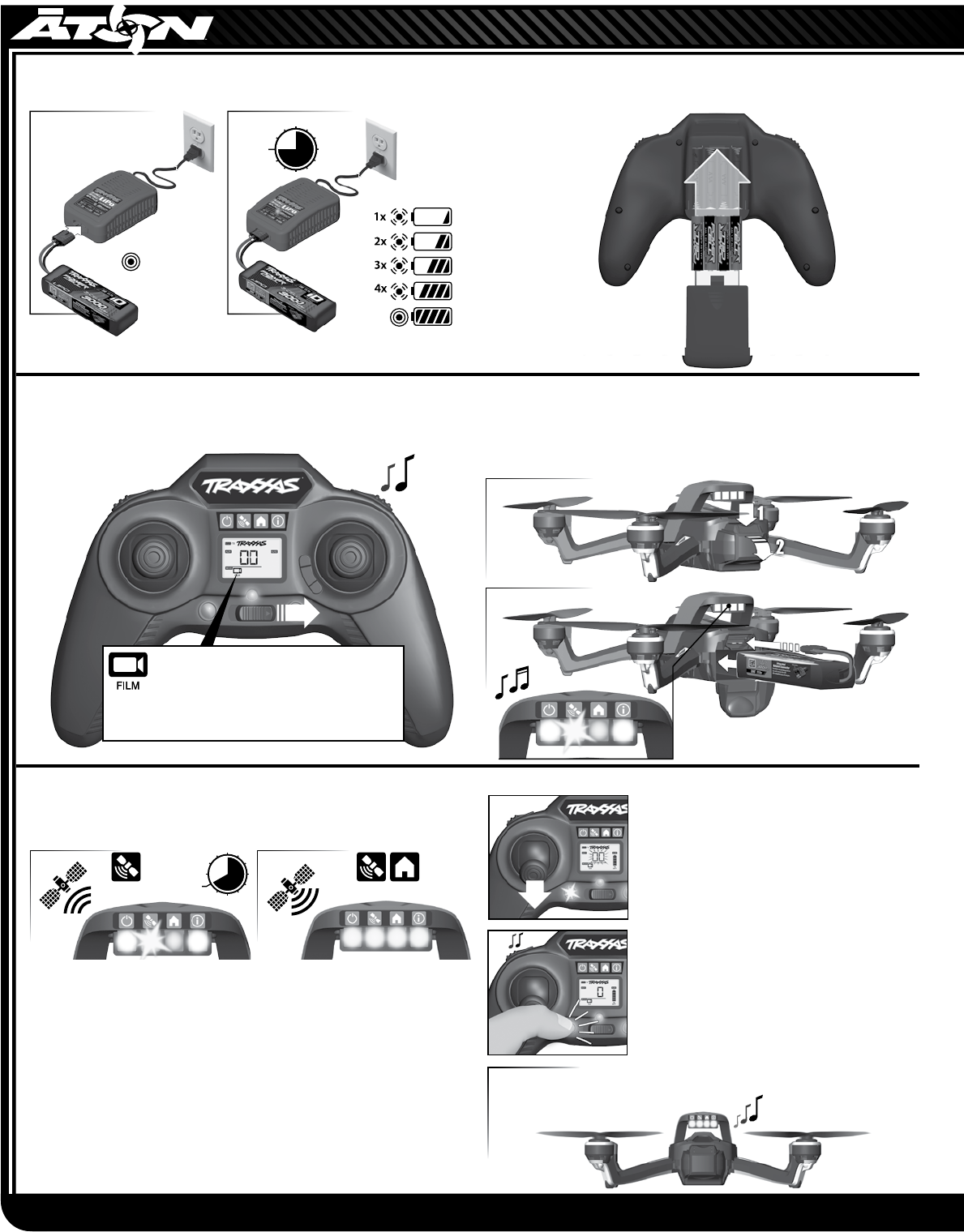
6 • TRAXXAS
5. Locating GPS Satellites
Āton is intended for outdoor flight. Select a flying location with a clear,
unobstructed view of the sky. Place the helicopter on a level surface
with the Status Bar facing you (nose out).
The helicopter will sound a descending tone indicating that the flight
system is ready. The GPS Status LED on the Status Bar will continue to blink
slowly while the helicopter is searching for GPS satellites (A). Once the GPS
position is established (usually about a minute), it will also glow solid.
The Home Status LED on the Status Bar will then glow solid indicating
that the current position of the helicopter has been set as the Return
to Home location (B). When all four LEDs on the Status Bar are solid
green, you are ready to take off!
Note: If a GPS signal can not be found, move the helicopter to a different
location. We recommend that you do not fly the model without GPS or
a Return to Home location (see “Flying without GPS” on page 9). These
features are critical to help prevent loss of your helicopter.
6. Arm your helicopter for ight
Move the throttle stick to the full down
position. The helicopter will not arm unless
the throttle stick is in the down position (A).
Press
and release
the Arm/Disarm button on
the transmitter to arm your model for take
off (B). The transmitter will emit a tone and
the Arm/Disarm button will glow solid green.
The helicopter will emit a long tone and all
four rotors will spin at idle speed (C). The
helicopter is armed and ready for take off.
Note: While idling, the helicopter will
automatically disarm when the throttle stick
is left in the full down position (zero on the
LCD screen) for 2 seconds in Film Mode or 15
seconds in Sport Mode, one or more of the
rotors are obstructed, or the helicopter detects
an impact.
A.
A. B.
CHARGE PROGRESS
C.
B.
A.
B.
AAA Alkaline x 4
30s- 45s
A. B.
GPS HomeGPS
Ready to Take O!
PREPARING FOR FLIGHT
3. Turn on the transmitter
The transmitter will emit a rising musical tone. Always turn the
transmitter on first, before connecting the helicopter battery.
WARNING! It is critical to follow all instructions for safe and proper use, charging,
and storage of LiPo batteries (see page 5).
4. Turn on the helicopter
Open the battery compartment (A). Install the fully charged battery with
the wires facing the rear of the model. Connect the battery. The helicopter
will emit a musical tone and the rear-facing Power and Info Status LEDs on
the helicopter will glow solid. The GPS Status LED will blink slowly (B).
2. Install batteries in the transmitter1. Charge the battery pack
Red LED
(Green LED)
45min
Green LED on
LCD screen ashing “00”
Conrm that the Āton is in Film Mode.
If it is in Sport (Fast) or Expert Mode,
press the control stick (ight stick,
Mode 2) to cycle through the modes. Press the
control stick until the Film Mode icon appears.
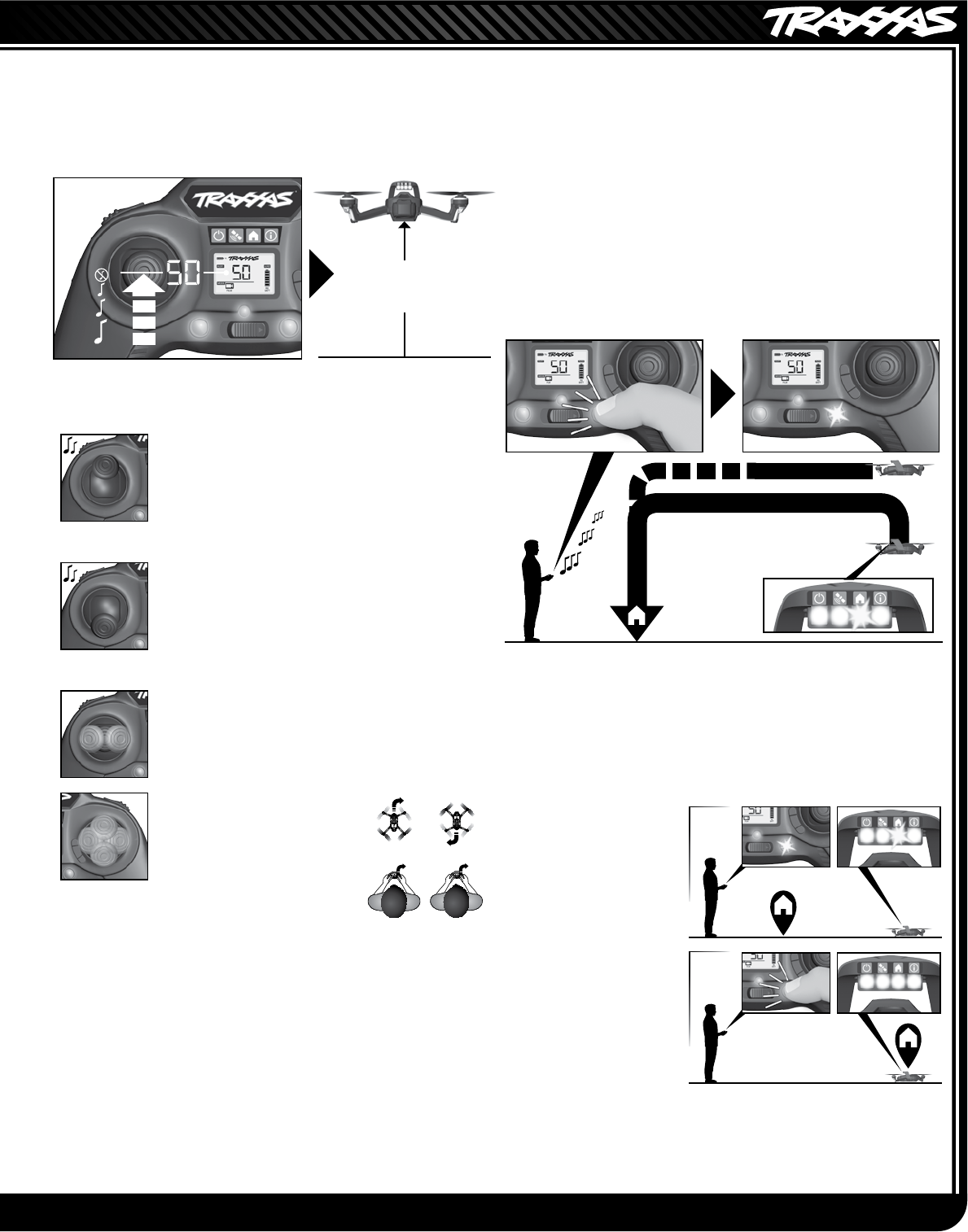
TRAXXAS • 7
AUTO TAKE-OFF
(Film Mode only) With the helicopter armed and idling, gently raise
the throttle stick to the center position (the LCD screen will read 50%).
The transmitter will emit a descending tone until you reach
the center
position. The center position activates Auto Take-Off.
The helicopter will
automatically take off and maintain hover at 8-10 feet (2-3 meters).
CONTROLLING ĀTON (FILM MODE)
Your helicopter is set by default to Film Mode. Film Mode is the easiest
to fly and will allow you to quickly become familiar with the controls.
• Fly Higher: Raise the throttle stick past the center
position and the helicopter will gain altitude. The
transmitter will beep a high tone alerting you that
it is climbing. The farther up you move the stick,
the faster it will climb. When the desired altitude is
reached, move the stick back to the center position
(no sound) and the model will maintain altitude.
• Fly Lower: Lower the throttle stick past the center
position and the helicopter will lose altitude. The
transmitter will beep a low tone alerting you that it
is descending. The farther down you move the stick,
the faster it will descend. When the desired altitude
is reached, move the stick back to the center position
(no sound) and the model will maintain altitude.
• Rotating (Yaw): Move the throttle stick left or right
to rotate the model around its center axis. This has
no effect on the altitude.
• Maneuvering: Move the
control stick in the direction
you want the model to travel.
The farther you move the
stick, the faster it will travel.
Note that if the helicopter has
been rotated so that the front
is facing you (nose in), then
the controls will seem reversed.
LANDING
When you are finished flying, either press the Return to Home button
to automatically land the helicopter (see Return to Home below) or
manually land the helicopter in a safe location by gently lowering the
throttle stick to the full down position. Once you have safely landed,
press and hold the fast blinking green Arm/Disarm button on the
transmitter for 2 seconds to disarm your model. The helicopter will not
disarm unless the throttle stick is in the down position.
RETURN TO HOME
When all four status LEDs are glowing solid, you can automatically
return to your original take-off location at any time during flight by
pressing the Return to Home button on the transmitter (A).
The Home status LED on the Status Bar and the Home button on the
transmitter will blink slowly (B). The helicopter will position itself with
the Status Bar facing the Return to Home location (nose out); then, it
will rapidly move in a straight flight path back to the home location,
descend, land, and disarm. The transmitter will emit a low-high-mid
tone indicating that the model is returning to home. If the helicopter
was flying at an altitude below 45 feet (14 meters), it will ascend to this
altitude; if it was flying at an altitude above 45 feet (14 meters), it will
maintain its current altitude while returning. Note: While the helicopter
is descending, the control stick can be used to land the Āton in a
different location other than the set home position.
Note: The pilot may at any time cancel Return to Home by pressing the
Air Brakes button.
If you press and hold the
Air Brakes
button, the Āton
will stop and hover in place. When you release the
Air Brakes
button, the
Āton will be operating in Film Mode. Depending on where the throttle
stick is located, Āton may be moving up or down. If necessary, adjust
the throttle stick to move up, move down, or hover.
Use this feature to
navigate around an obstacle in the Return to Home path of the model.
Press the Return to Home button on the transmitter to reactivate.
Resetting Home Location
When you land and disarm
the helicopter away from
the original home location,
the Home Status LED and
the Return to Home button
on your transmitter will both
blink fast (A).
You can set the new
position as the Return to
Home landing location by
pressing the blinking Return
to Home button on the
transmitter (B).
Note: If you do not wish to
reset your home landing
location, arm the helicopter
and continue flying. Āton will retain the original home location.
8-10 feet
(2-3 meters)
45 feet (14 meters)
Below 45 feet (14 meters)
Above 45 feet (14 meters)
B.
A. B.
A.
B.
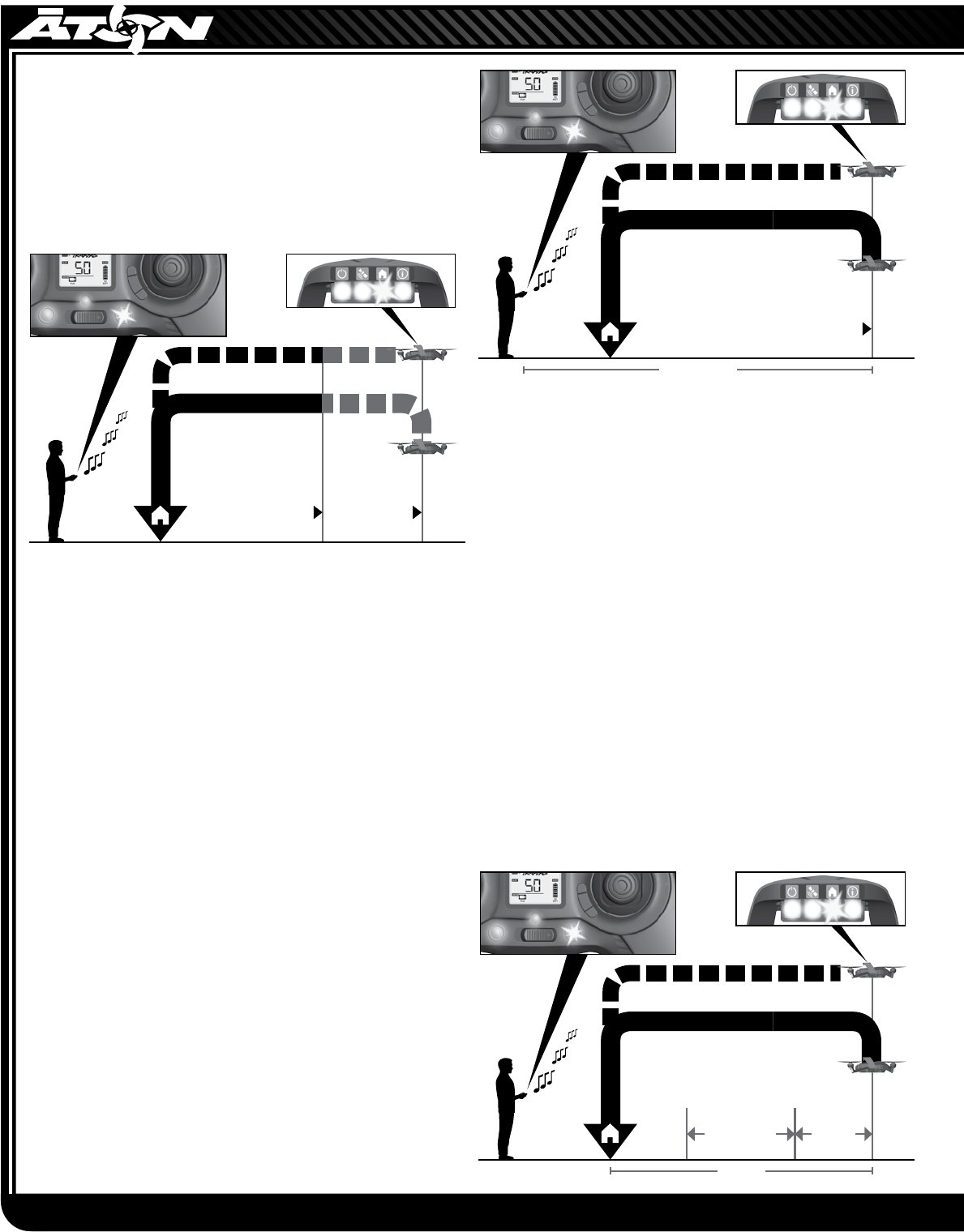
8 • TRAXXAS
Return to Home - Out of Radio Control Range Failsafe
The transmitter and helicopter are equipped with an automatic fail-safe
system. In the event of signal loss or interference,
the transmitter will
automatically switch to Film Mode and the transmitter
will emit the
Return to Home sound (low-high-mid tone followed by a beep). The
helicopter will automatically return to the home location, land, and
disarm (with a set home location) or immediately land and disarm
(without a set home location; see “Flying without GPS” on page 9).
Determine the reason for signal loss and resolve the problem before
operating the helicopter again.
Note: If a control signal is reestablished between the transmitter and
receiver along the return to home flight path, you may cancel Return
to Home by pressing the Air Brakes button
(see “Air Brakes” on page 11).
Release the button to regain complete control of the model in Film Mode.
Return to Home - Geofence Breach
Āton comes congured with a GPS-controlled boundary (geofence)
with a radius of approximately 500 feet (150 meters). When Āton
ies beyond this boundary, it will automatically return to home. The
transmitter will emit the Return to Home sound followed by 2 beeps,
indicating a geofence breach. Once inside the geofence, you may
press the Air Brakes button to cancel return to home and continue
ying in Film Mode. The geofence boundary does not represent the
control range of the radio system. You may use the Traxxas Flight
Link application to modify the distance of or remove the geofence
boundary. Removing the geofence boundary can create situations
where the Āton at far distances may perform autonomous behavior
(such as Return to Home) and won’t be able to communicate to the
operator what it is doing until it is back within telemetry range. The
geofence boundary keeps Āton approximately within telemetry range
for two-way communication between Āton and the operator.
Return to Home - Low Voltage Failsafe (Telemetry)
Within a range of about 500 feet (150 meters), the helicopter has
2-way communication with the transmitter and will alert you when
the battery level is low. When the battery is nearly discharged
(approximately 30 seconds before entering low voltage emergency
reserve mode), the transmitter will emit a tone every 5 seconds.
Immediately fly the helicopter to a safe location and land it. In the
last 5 seconds, the tone will be continuous. After that, the transmitter
will emit the Return to Home sound (low-high-mid tone followed by
3 beeps) and the helicopter will automatically return to the home
location, land, and disarm. If necessary, use the Air Brakes button to
cancel Return to Home to steer around unexpected obstacles in the
return to home path. Once clear, press the Return to Home button
again to continue, or maneuver and land the Āton on your own as
quickly and safely as possible. WARNING: DO NOT always rely on the
emergency reserve return to home function to land. Conditions
such as distance, wind, and temperature can affect the battery’s end
of charge reserve, resulting in a shutdown in flight. DO NOT ignore
the first battery low voltage warning, but safely return and land as
soon as possible. To prevent permanent damage to your battery
pack, ALWAYS disconnect the battery whenever the helicopter is
not in use. Please note that if you have disabled or increased the
radius of the default geofence, this will affect your ability to receive
battery alerts. Refer to the the section “Flying without the Geofence
Protection” on page 9 for more information.
Telemetry
Range Limit
Control
Range Limit
45 feet (14 meters)
+1 Beep
+1 Beep
+1 Beep
+3 Beeps
+3 Beeps
+3 Beeps
45 feet (14 meters)
Timeline
Low Battery
Warning Tone
Urgent
Warning
Tone
Below 45 feet (14 meters)
Above 45 feet (14 meters)
Geofence
Boundary
Below 45 feet (14 meters)
+2 Beeps
+2 Beeps
+2 Beeps
45 feet (14 meters)
Flying Range
Approximately 500 feet (150 meters)
Below 45 feet (14 meters)
Above 45 feet (14 meters)
Above 45 feet (14 meters)
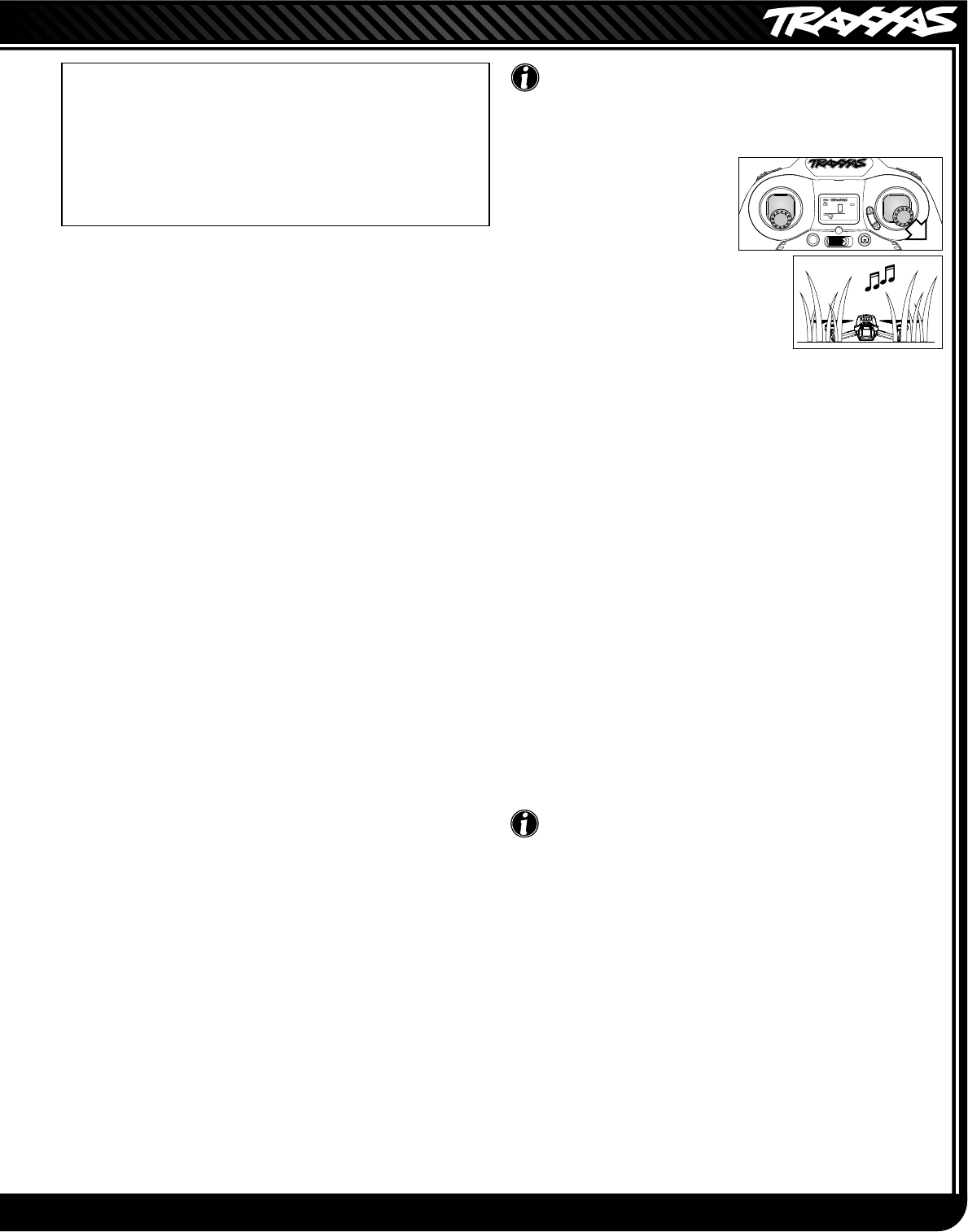
TRAXXAS • 9
*Compatible with GoPro® Hero3, Hero3+, or Hero4
Flying without GPS (without a Return to Home Location)
WARNING: The Āton has tremendous power and capability; it
can very easily get out of your line of sight. Flying the helicopter
without a satellite GPS signal and a set Return to Home location
has the risk of losing your helicopter. We do not recommend flying
Āton without GPS fully enabled and functioning. If the helicopter
encounters an emergency situation during flight without GPS, such
as loss of the radio control signal or critically low battery, Āton will
attempt to safely land and disarm. This can result in loss of the Āton
if it is, for example, over water or some other area where it can’t be
retrieved. To help prevent problems, always fly with GPS enabled
and avoid flying over areas where an unexpected emergency
landing could endanger the Āton or nearby people and property.
If for some reason you decide it is necessary to operate Āton without
GPS, you can override the satellite search function by pressing and
holding the Arm/Disarm button on the transmitter for 2 seconds. This
will arm the helicopter for flight, but the Return to Home function will
be deactivated (the GPS Status LED on the Status Bar will continue to
blink green slowly during flight).
When you are finished flying, land the helicopter in a safe location.
Move the throttle stick to the full down position. Press and hold the
fast blinking green Arm/Disarm button on the transmitter for 2 seconds
to disarm your model. The helicopter will not disarm unless the throttle
stick is in the full down position.
Note: If a satellite GPS signal is found during flight, the GPS Status LED
on the Status Bar will glow solid green indicating that the Return to
Home function is now active. This location will be set as the Return
to Home location. To choose a different location, land the helicopter,
disarm it, and then follow the instructions in the “Resetting Home
Location” section on page 7.
Flying without the Geofence Protection
The Āton is programmed with default geofence protection that keeps
Āton within the range of the telemetry communication. The geofence
radius is set to about 500 feet (150 meters) and can be adjusted or
removed using the Traxxas Flight Link App. If you remove the geofence,
you can encounter situations where the Āton is flying autonomously
(such as Return to Home) without providing information to the pilot
about its actions until it flies within telemetry range. Once in range,
the tansmitter will provide alerts to the pilot. For example, if the Āton’s
battery reaches the end of its charge while the Āton is flying beyond
telemetry range, the pilot will not receive the progression of prompts
from the transmitter to return and land. When the battery reaches its
critical threshold, Āton will return to home automatically without alerting
the pilot until Āton is inside telemetry range with the Return to Home
sound followed by three beeps. When you observe the Āton flying
autonomously and returning to home, do not cancel return to home until
you receive an alert that informs you of the reason it is returning to home.
If the reason is a low battery, then allow Āton to return and land on its
own. We recommend that pilots do not disable or extend the geofence
range unless they are fully familiar and confident in how the Āton
responds to different circumstances.
If one or more of the rotor blades are obstructed, the helicopter
will disarm itself. Move the helicopter to a clear area, remove
the obstruction, arm the helicopter again, and continue flying. If the
helicopter will not fly correctly, unplug the battery and inspect the
helicopter for damage.
“FIND ME” BEEPER
If the helicopter lands and disarms
out of your line of sight, it is
equipped with a beeper to help
determine its location. To activate
the beeper, move the throttle stick
on the transmitter to the full down
position
(
the beeper will not activate
unless the throttle stick is in the down
position); then, move the flight stick
right and back.
HELPFUL FLYING TIPS
Controls are reversed as the model flies toward you.
• When your model is flying away from you, the helicopter reacts to
direction changes just as you command. If you command the model
to move right, it will move to your right as you commanded.
• When the helicopter is coming toward you and you command
the model to move right, the model will move to your left. Always
remember that the model flies forward, reverse, right, and left relative
to the position of itself, not relative to your position.
• Until you become used to reversing your control inputs as the model
changes direction, allow yourself extra flying room to accommodate
pilot error.
• To help with directional control, it may help to imagine yourself
sitting in the cockpit of the helicopter.
• The model will react quickly to your commands. At first, move the
controls SLOWLY and make small, gentle control movements to
avoid loss of control. If you ever feel you don’t have complete control
of the helicopter, maintain altitude with the throttle stick and release
the opposite stick to return to level flight (Film and Fast Mode).
• Fly the Āton with the Status Bar facing you (nose out) until you
become familiar with the flight controls and different behaviors of
the helicopter.
• Fly at least 8-10 feet (2-3 meters) above the ground to avoid ground
turbulence for a more stable and controllable flight.
Be prepared for altitude changes as you fly. Forward/reverse
and left/right movements may increase or reduce lift, causing
the helicopter to gain or lose altitude. Be prepared to react to altitude
changes by adjusting the throttle as you fly the model.
Return to Home is Your Extra Security
Āton’s sophisticated Return to Home functions are there to
help whenever you need it. If you ever encounter a dicult or
uncomfortable situation, such as losing directional orientation, loss
of visual contact, high winds, ying too high and so on, simply press
the Return to Home button. Let Āton bring itself back to you quickly
and safely. Āton’s Return to Home function can be especially helpful
if you are learning how to y for fun in Sport or Expert Modes.